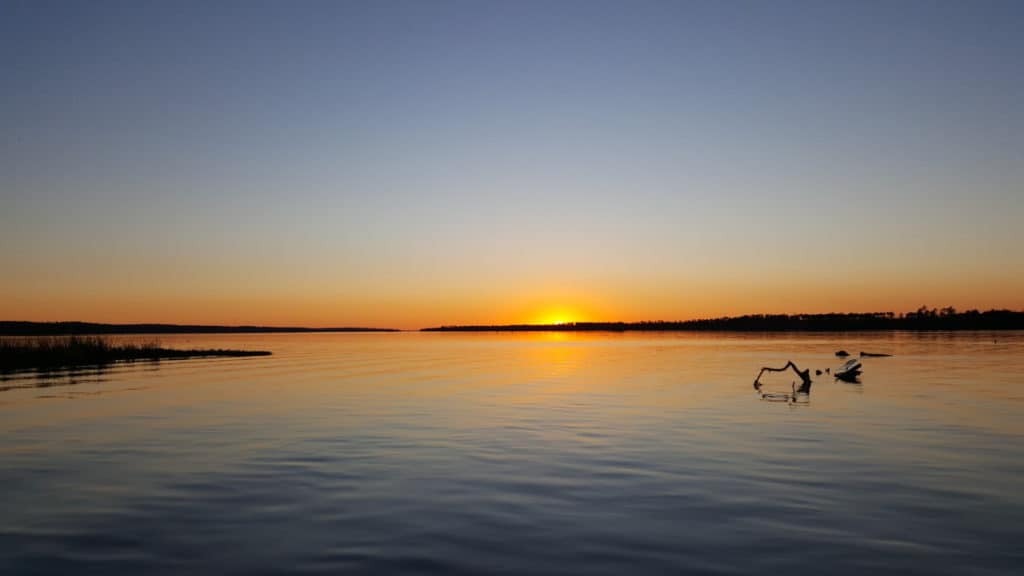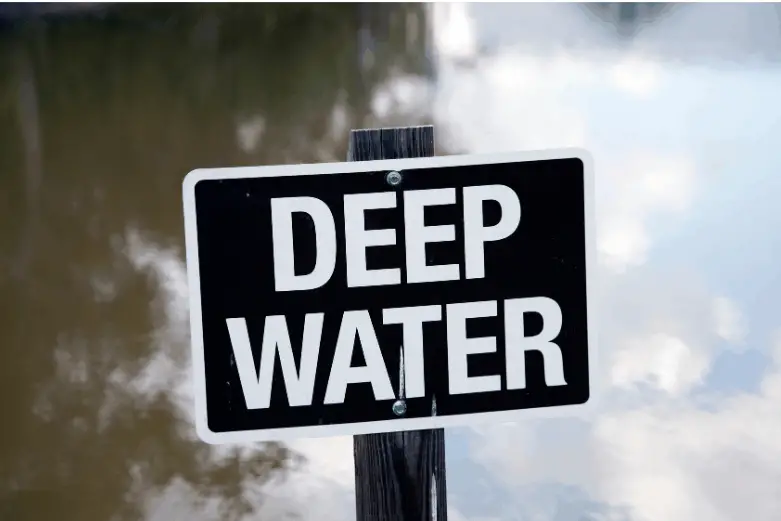
Bass choose their preferred habitat based on a wide variety of factors, including cover, structure, and other relevant factors. Finding the spots they like most in a given body of water is KEY to hooking up more often. One of the first things many try to figure out is whether they should start fishing in shallow or deep water.
Bass like shallow water during the spring because of spawning activities. Fall means a bait migration to shallow water, so bass tend to follow for prey. Bass like deep water during more extreme weather in summer and winter so that they can find more stable temperatures with better oxygen levels.
As mentioned, bass move to different layers of the lake primarily because of changes in air temperature, which inevitably affects water temperature as well. Below, I’ll discuss the seasonal movements of bass relative to water depth. I’ll also mention spawning behaviors as they relate to deep and shallow water for bass.
| Shallow Water | Deep Water | |
| Winter | ||
| Spring/Pre-spawn | ||
| Spring/Spawn | ||
| Spring/Post-spawn | ||
| Summer | ||
| Fall |
How “Deep” is Deep Water and How “Shallow” is Shallow?
Seems like an odd question. The short answer is that “deep” is deep only when compared to the rest of the lake. It’s relative to the entire body of water.
For example, in a Florida lake where the entire fishery is no more than 10 feet deep, 9 feet is “deep” in that particular situation. However, if you’re on a lake like Hartwell or Lanier that can see depths up to 150 or 200 feet, then 9 feet is relatively shallow.
Remember to consider your fishery’s average depths in the information below when planning your fishing strategy.
Are Bass Deep or Shallow in the Winter?
In wintertime, bass are typically in temporary homes in deeper water. This is because they have found a stable environment to deal with their slower metabolism during this time of year.
During this time of year, bass look for water that helps them deal with low water temperatures. So they’ll stay deep until the water temperatures warm up in the spring.
Read more on wintertime strategies in Bass Fishing Insider’s article, How to Catch Bass in the Winter in Florida (9 Proven Tips).
Do Bass Like Shallow or Deep Water in the Spring?
As winter comes to a close and after ice-out (for colder states and climates — see Bass Fishing Insider’s Article on How to Catch Bass Right After Ice Out), bass begin to think about the spawn. As the spawn approaches, bass move from their deeper haunts to shallower water.
Why? Bass move to shallow water during the early spring for a good reason. They are looking to protect and nurture their eggs. The eggs need warmer surroundings and more light to have the best chance of survival and hatching.
Additionally, spring means active micro-ecosystems on land, which means bait like crawfish, snakes, lizards, frogs, and other prey are more plentiful near the shoreline (shallow). Needless to say, the bass will follow the food, so shallow haunts are an excellent place for finding bass during this time of year.
Below, I give special attention to a special season for Bass: the spawn. As you’ll see, the spawn is predominantly a springtime event. During this time of year, bass operate on a schedule directly related to spawning. Different stages of the spawn usually mean that bass are looking for different water depths. So are bass deep or shallow during the spawn?
Pre-Spawn
Pre-spawn activities usually begin early in the spring season. Bass are not yet ready to move up to spawning grounds, so they “stage” at certain locations around the lake. They generally can be found in deeper areas located NEAR spawning flats or other spawning locations.
Points, ledges, channels, and other structures near spawning flats are all great places to start. These are generally mid-level depth spots, so they are not too deep and not shallow yet. (source) Use charts, Navionics, and your graphs to locate the best spots. During this period, bass may move from deep to shallow as the water temps fluctuate and chase bait moving in and out of shallow water.
Rattle Traps are a great way to cover a ton of water during pre-spawn periods.
Spawn
When water temperatures rise (to at least 55 degrees), bass will move from deeper staging areas to shallow flats or other protected areas to bed. It is typical for bass to move in and out of shallows early in their spawn season because shallow water temperatures can rise and fall rapidly with changing weather conditions.
- As the water warms, fish move shallow.
- As it cools with any cold front, the bass may move deeper but generally won’t retreat all of the way to their pre-spawn staging areas.
Bass can spawn in varying depths but usually make beds in water between 2 and 10 feet. However, here in Florida, we regularly see beds in very shallow water, often less than 2 feet deep.
Check out this great read loaded with information on how to catch bass in the spawn.
Bass Insider Tip
If you’ve found beds and notice smaller males on the beds, that may mean that the female is close by in waiting. Consider the nearest deep water structure to look for the bigger females. By thinking outside the box a bit, you could find a lunker waiting out deeper to move up and spawn.
Post-Spawn
Post-spawn bass behavior is similar to pre-spawn bass behavior in many ways. Bass begin the move out of their spawning areas towards deeper water. (source) They’ll stop at many of the same places that they staged on during the pre-spawn period. Once again, ledges, channel swings, points, and other deep water structures close to spawning areas should hold fish.
According to Johnke, a Southern Illinois University study found that,
“among other particulars, that after the spawning period only 1.2 percent of the bass were back by the shoreline at any given time. After spawning has been completed, 98 percent of the fish spend the majority of their time away from the shallows and are in deeper water. “ (source)
How Deep Do Bass Go in the Summer?

Bass typically stay in more shallow water until the water starts to heat up during the early summer months. Then, when water temps push into the mid to high eighties, bass will begin to move deeper where they can find more well-balanced, colder water.
As mentioned above, bass head to deeper water during hot weather months to look for a more stable water column where the water temps don’t fluctuate as much with the changes in air temperature. Additionally, oxygen content stays more consistent in these deeper water habitats, which helps the bass to thrive in tough summer months.
Side note– one of my favorite ways to target deep water bass is using a drop shot. Check out this great setup to keep things simple.
Once again, follow the food = find the bass. Shad, bluegill, shiners, and other prey also head to deeper water during summer. The result – BASS FOLLOW!
If you’re wondering how deep bass will go, bass will head as deep as possible without sacrificing a healthy oxygen-rich environment. Maximum depths are relevant to each body of water. Be careful not to fish too deep; the bass may be non-existent because of the oxygen-depleted water.
When exploring deep water for bass, pay attention to offshore structure COMBINED with some sort of cover like a sunken brush pile on a main lake point, submerged grass beds near a contour-rich hole, deepwater stumps near a channel swing, etc. For in-depth (pardon the pun) info on hot weather fishing, check out 11 Helpful Tips for Summer Bass Fishing Success.
Bass will stay in deep water primarily until water temps begin to drop in the early fall.
Bass Fishing Insider Tip
Although conventional wisdom suggests that bass head to deep water during the hot summer months, don’t ignore shallow waters entirely. The key to shallow water fishing for bass during the summer is to fish it RIGHT.
Bass seek shade, cover, and cooler water. Find any of those elements in shallow water, and you may be able to entice a bass to bite. Look for the following elements during the hot summer months to find shallow-water bass:
- Shade- docks, overhanging bushes, trees, etc. Try skipping a jig to dock shade for great results. I like the Z-man Crosseyez Flipping Jig best for this technique (found on Amazon).
- Cover– matted vegetation, lily pads, etc.
- Cooler water– rainwater runoff, streams, falls. Find anything that makes the water different (cooler) than the surrounding hot water. For example, one time, I found a small waterfall with active water emptying into a lake. The entire lake was on fire with very warm water. The waterfall provided an area of cooler water and respite for the fish. Bass were congregated there as a result.
- Springs — Spring water can be a source of colder water relative to the rest of a lake. The trick is not to fish too close to the spring. Fish are not as active right at the spring source. Get away from the spring, where the water spreads into the rest of the main body of water but still has a cooling effect. Those areas will be more productive.
Where to look for Bass in the Fall, Shallow or Deep?
With the onset of fall, water temps begin to drop, which means bass start to retreat from their summer deep water hangouts and begin their journey back to shallow water to look for food.
As fall approaches, prey like shad and other baitfish move shallow again, leading to a bass migration toward the bank.
Look for bass to head to creeks and other shallow-water hangouts as they seek forage. Follow the bait to find the bass!
Are Bigger Bass in Deeper Water?
In his work, “The Behavior and Habits of Largemouth Bass,” Johnke postulates that larger bass make their homes mainly in deep water because of their survival instincts. He stated that bass head to deeper water to escape noise, pressure, and water disruption, among many reasons.
Johnke noted that he believed that big bass associated activity with a threat. To escape activity, bass head to deeper water because deeper water is quieter, which means bass associate deep water with safety. (source)
The Bass Line.
To understand what depth to catch bass in, you should carefully consider water temperature, the presence of bait, and special situations like the spawning periods. By taking a little time to understand bass behavior relative to these factors, you’ll gain an understanding of whether bass like shallow or deep water during your particular time of year.
Time to get out on the water. Fish on!




